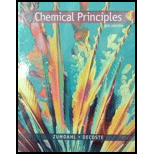
Concept explainers
(a)
Interpretation: The electronic configuration of
Concept Introduction: The electronic configuration of an atom or ion represents the distribution of electrons in the atom or ion. It represents the sequence of atomic orbitals in the increasing order of their energy.
In each orbital, the electrons must be filled according to their maximum capacity. For example; s-orbital can accommodate 2 electrons, p-orbital can accommodate 6 electrons, d-orbital can accommodate 10 electrons and f-orbital can accommodate 14 electrons maximum.
(a)
Answer to Problem 7E
Explanation of Solution
The
(b)
Interpretation: The electronic configuration of
Concept Introduction: The electronic configuration of an atom or ion represents the distribution of electrons in the atom or ion. It represents the sequence of atomic orbitals in the increasing order of their energy.
In each orbital, the electrons must be filled according to their maximum capacity. For example; s-orbital can accommodate 2 electrons, p-orbital can accommodate 6 electrons, d-orbital can accommodate 10 electrons and f-orbital can accommodate 14 electrons maximum.
(b)
Answer to Problem 7E
Explanation of Solution
The atomic number of Cu is 29. It is placed in the group-IB of the periodic table. It is a transition element therefore the 3d orbitals must be filled before 4s orbital. But to form the cation, the electrons must be removed from the outermost shell of the atom. Therefore the electronic configuration of
(c)
Interpretation: The electronic configuration of
Concept Introduction: The electronic configuration of an atom or ion represents the distribution of electrons in the atom or ion. It represents the sequence of atomic orbitals in the increasing order of their energy.
In each orbital, the electrons must be filled according to their maximum capacity. For example; s-orbital can accommodate 2 electrons, p-orbital can accommodate 6 electrons, d-orbital can accommodate 10 electrons and f-orbital can accommodate 14 electrons maximum.
(c)
Answer to Problem 7E
Explanation of Solution
The atomic number of V is 23. It is placed in the group-VB of the periodic table. It is a transition element therefore the 3d orbitals must be filled before 4s orbital. But to form the cation, the electrons must be removed from the outermost shell of the atom. Therefore, the electronic configuration of
Want to see more full solutions like this?
Chapter 19 Solutions
CHEM.PRINC.W/OWL2+REBATE+2 SUPPL.>IP<
 Chemistry: An Atoms First ApproachChemistryISBN:9781305079243Author:Steven S. Zumdahl, Susan A. ZumdahlPublisher:Cengage Learning
Chemistry: An Atoms First ApproachChemistryISBN:9781305079243Author:Steven S. Zumdahl, Susan A. ZumdahlPublisher:Cengage Learning ChemistryChemistryISBN:9781305957404Author:Steven S. Zumdahl, Susan A. Zumdahl, Donald J. DeCostePublisher:Cengage Learning
ChemistryChemistryISBN:9781305957404Author:Steven S. Zumdahl, Susan A. Zumdahl, Donald J. DeCostePublisher:Cengage Learning
 Chemistry: Principles and PracticeChemistryISBN:9780534420123Author:Daniel L. Reger, Scott R. Goode, David W. Ball, Edward MercerPublisher:Cengage Learning
Chemistry: Principles and PracticeChemistryISBN:9780534420123Author:Daniel L. Reger, Scott R. Goode, David W. Ball, Edward MercerPublisher:Cengage Learning Chemistry & Chemical ReactivityChemistryISBN:9781337399074Author:John C. Kotz, Paul M. Treichel, John Townsend, David TreichelPublisher:Cengage Learning
Chemistry & Chemical ReactivityChemistryISBN:9781337399074Author:John C. Kotz, Paul M. Treichel, John Townsend, David TreichelPublisher:Cengage Learning Chemistry & Chemical ReactivityChemistryISBN:9781133949640Author:John C. Kotz, Paul M. Treichel, John Townsend, David TreichelPublisher:Cengage Learning
Chemistry & Chemical ReactivityChemistryISBN:9781133949640Author:John C. Kotz, Paul M. Treichel, John Townsend, David TreichelPublisher:Cengage Learning





